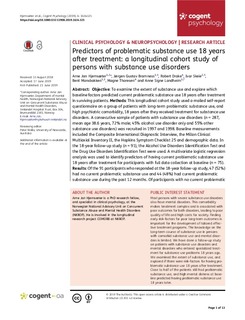Predictors of problematic substance use 18 years after treatment: a longitudinal cohort study of persons with substance use disorders
Hjemsæter, Arne Jan; Bramness, Jørgen Gustav; Drake, Robert; Skeie, Ivar; Monsbakken, Bent Berntsen; Thoresen, Magne; Landheim, Anne
Peer reviewed, Journal article
Published version

View/
Date
2019Metadata
Show full item recordCollections
Abstract
Objective: To examine the extent of substance use and explore which baseline factors predicted current problematic substance use 18 years after treatment in surviving patients. Methods: This longitudinal cohort study used a mailed self-report questionnaire on a group of patients with long-term problematic substance use, and high psychiatric comorbidity, 18 years after they received treatment for substance use disorders. A consecutive sample of patients with substance use disorders (n = 287, mean age 38.6 years, 72% male; 45% alcohol use disorder only and 55% other substance use disorders) was recruited in 1997 and 1998. Baseline measurements included the Composite International Diagnostic Interview, the Millon Clinical Multiaxial Inventory II, the Hopkins Symptom Checklist 25 and demographic data. In the 18-year follow-up study (n = 91), the Alcohol Use Disorders Identification Test and the Drug Use Disorders Identification Test were used. A multivariate logistic regression analysis was used to identify predictors of having current problematic substance use 18 years after treatment for participants with full data collection at baseline (n = 75). Results: Of the 91 participants who responded at the 18-year follow-up study, 47 (52%) had no current problematic substance use and 44 (48%) had current problematic substance use during the past 12 months. Of participants with no current problematic substance use, 17 (36%) reported total abstinence from alcohol, illicit substances and misuse of pharmaceuticals during the past 5 years. Mental distress measured with the Hopkins Symptom Checklist 25 at baseline predicted having current problematic substance use 18 years after treatment (n = 75). Conclusions: In a group of patients with long lasting substance use disorders and high psychiatric comorbidity that entered treatment, close to half of those participating at a follow-up study had current problematic substance use during the past 12 months 18 years later. Mental distress at baseline predicted having current problematic substance use 18 years after treatment, adjusted for other factors. Self-reported general mental health symptoms can be a relevant predictor of the long-term course of substance use disorders.